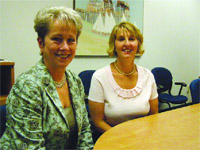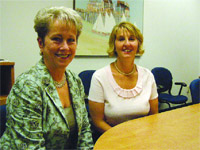
Still a Work In Progress
The Employment Picture Is Improving, but It Remains Fuzzy
The July unemployment numbers released by the U.S. Department of Labor were lower than expected. Thats the good news.
However, the difference between the projected figure and the 9.4% unemployment statistic for that month was a tenth of a percent. Thats not too bad for news these days.
Across the nation in July, employers trimmed 247,000 jobs, in contrast to the staggering January losses of 741,000. On the day the unemployment numbers were released, President Obama said that the worst may be behind us, and that we are pointed in the right direction.
The Bay State posted a seasonally adjusted 8.6% unemployment rate for the month of June, and while there were other Mass. communities that spiked into double digits, Hampden County edged below, at 9.8%.
Thats still a large number, and its reflected in what Rexene Picard, executive director of FutureWorks in Springfield, one of 37 statewide career centers, observes every day. The big thing that were seeing is increased traffic for job seekers. Theres a line out the door when we open. At the same time, we are seeing fewer job opportunities. Our job postings have gone down from this time last year about 38%. Thats a significant drop.
At United Personnel in Springfield, owner Mary Ellen Scott and Executive Vice President Christine Phillips took a positive look at the local job market. Talking about the manufacturing sector, historically one of the backbones of the local economy, Scott said that our business has definitely been picking up over the last few months.
Joe Ascioti, owner of Reliable Temps Inc. in Agawam, feels less buoyant about the governments predictions. While the latest statistics are better than feared, he said, lets face it, we arent creating a lot of new jobs yet. Theres still too much uncertainty out there right now.
In these days of economic turmoil, a reduction in bad news is good news, most would agree. Massachusetts has consistently been at the lower end of the nations unemployment rates, but in talking with area employment professionals, the big question is, when does the good news get good?
Local Looks
While the number of job-seekers and the dearth of jobs Picard sees everyday are both somewhat historic, she is confident in programs that are available for area workers.
Western Mass. is better in some ways than the Boston area because we dont see the highs nor the lows that they do, she said.
Some new growth in the job market comes from familiar sources, she continued. Health care is, and continues to be, the leading source of employment for this area and the state.
Our largest employer in the area is Baystate Medical Center, she continued. They are reaching out to us now, because we know that there is going to be a need to hire around 1,000 people a year for the next several years. Anybody thats thinking about a new career, or switching gears, I encourage them to look at that field.
In the manufacturing and construction sectors, new claims for unemployment in Hampden County totaled more than 3,000, and Picard agreed that the bulk of her June numbers comprised those industries. But with funds from the American Recovery and Reinvestment Act, one of the largest stimulus packages in history, funds have come through the pipeline to address those losses. Picard said shes pleased to see substantial money going into both new training and retraining for the manufacturing base of the area.
But its difficult, she continued, because this money essentially is going to replacement jobs. Not a lot of new companies are moving to the area.
Manufacturing continues to be an important facet to the regional workforce, despite decades of offshore attrition. Picard said that the Regional Employment Board of Hampden County is involved with numerous initiatives to keep people in those positions.
The manufacturing industry constitutes 17% of the area workforce, and those generally are jobs that are well-paying positions, she said. The REB is doing a lot of work in the area with manufacturers, asking where the need is for new employees and what they can do to successfully build pipelines into those industries. Its an aging workforce in many cases.
Phillips and Scott say there are signs of some light at the end of the tunnel for the manufacturing sector, and theyre seeing it in the growing number of positions theyre being hired to help fill.
I dont think we were expecting manufacturing to be doing as well as we have seen already this year, said Scott. Phillips agreed. It has picked up, and it is definitely where we have seen the biggest trend change. We were not anticipating certain clients to have needs this year; our analysis was that we werent planning on having any orders.
The improving picture can be attributed in part to what appears to be greater consumer confidence, as reflected in some of the numbers being posted by retailers, said Phillips.
I think that if you look at certain other sectors, lets say retail, their numbers began the year pretty low, she said. What they predicted for this quarter has been completely surpassed. There was a real concern about what kind of money would be spent. What retailers are seeing is that people are still spending. Thus, analysts look from this time last year to now, and their orders are far greater than they had anticipated.
Phillips and Scott agreed that the numbers these days are not as good as they would like them to be. While some clients are hiring more than they anticipated, many employers are, by and large, holding out for more assurance that the economy will strengthen.
Frankly, said Phillips, Id be more nervous if we were making giant leaps in gains in the economy. It is more-steady gains that build peoples confidence. If it goes up in a sharp increase, people think that it could similarly go down in a sharp decline.
Ascioti told BusinessWest that he sees government forces sometimes playing a contradictory role with regard to the employment picture. Unemployment taxes can be punishing to small business, and that size employer is one that needs to be given more consideration, he maintained.
What Im worried about right now, he said, is where are we going with all this? As the saying goes, Wall Street doesnt like uncertainty; well, neither does small business. Unemployment costs for many businesses are going to go up 30%. For politicians in Boston to think that they can just raise the sales tax, raise the meals tax, raise this, mandate that, and that businesses are just going to sit there and say, oh yeah, no problem. Well just raise our prices well, its not an elastic environment. You cant just do that.
In this area, he said, a lot of what he hears is that business is still off 25% to 30%. We have a couple of clients that are doing better than normal, he said. Are they where they were a year and a half ago? No. Are they better than 80% of what their competition is doing? Yes. But can I pick one specific industry? Unfortunately, no.
Looking at the larger forces of federal and state regulation, Ascioti said, what we need to do right now is bring our costs in line. I wish the government would understand that its small business that creates the jobs in America. If the climate isnt positive for them, its going to be impossible to hire people.
Hire Ground
The day after the newest unemployment figures were released, the New York Times reported that employers are no longer in a panic, and the pressure they felt to get rid of workers in a hurry is diminishing. That seems to be the sentiment in the Pioneer Valley, but the overall employment picture remains fuzzy because there are too many variables to make a clear assessment.
One thing is fairly certain, however: until the economy gains both momentum and sustained stability enough for employers to take on more workers, the only real good news is that the bad news is getting better.






